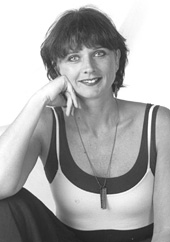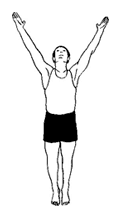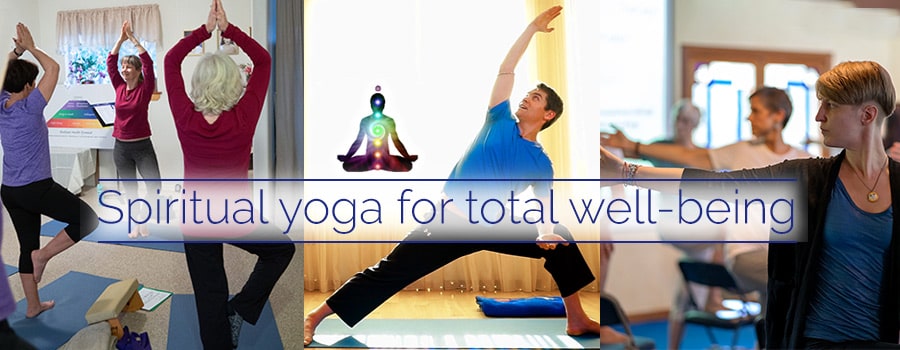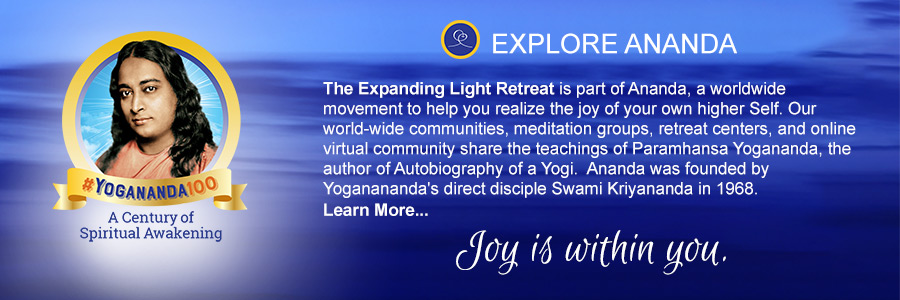Nuclear Yoga
Teaching Stress Reduction and Yoga in the Corporate World

Trina Ford
Recently I was asked to do a four-hour seminar for stress reduction at the Savannah River Site (SRS), a nuclear facility near my home in South Carolina. I was very surprised and excited to have this opportunity. I’ve done short presentations before for the U.S. Department of Energy, Westinghouse, and Wackenhut at SRS, but never a seminar. This was new and something I have been looking forward to. I immediately said, “Yes!”
I’d like to share with you my experience with this seminar, so first let me tell you a bit about SRS and about myself.
The Savannah River Site was established in the 1950’s to support the national defense during the Cold War. After the end of the Cold War, the mission of the site changed from production of nuclear materials to, primarily, cleanup (reprocessing) of “used” nuclear materials. The site, which occupies 310 square miles, has also been designated as a National Environmental Research Park and is home to many endangered animal and plant species, which are now protected accordingly. Wackenhut Services, the security contractor for the site, specifically asked for yoga and other stress-reducing techniques such as massage and reflexology.
I’ve been involved in yoga for over 20 years, and teaching for more than 12. When I received Ananda Yoga Teacher Training in 1998, I felt truly blessed and enriched in so many ways. All my experience couldn’t match what I received in that month of training. It gave me the confidence I needed for this seminar.
Also, my National Certification in Massage and Bodywork complements yoga in many ways, and has only enhanced my yoga life and career. I have a yoga and bodywork center — Integrative Bodyworks — with a staff of three therapists and five yoga teachers. We are doing well and keeping the teaching pure and simple. Our bodywork and/or massage therapy also reflects our yoga practice. Yoga is at the center of all we do.
Overview of the Seminar
The seminar was four hours long. The first two-and-a-half hours were entirely yoga practice. We began with introductions and Energization Exercises, which I believe are essential for the beginner. Then I led them in warm-ups and gentle foundation postures such as padahastasana and bhujangasana. I also talked about affirmations and how to use them in stressful situations — “I am calm, I am poised” or “I rise joyfully to greet each new day.” We ended the yoga section with savasana and a short meditation.
After a 15-minute break, we concluded the seminar with an hour-and- a-quarter section on bodywork. Following is a step-by-step description of what I did:
Introductions
I had been told in advance that most of the 40 participants (there were a few more who came and went because of their schedules) would be administrative staff, with a few supervisors.
On this basis, I had developed a class plan, but I still wanted to know why these particular individuals signed up. So I asked them to gather in a circle, then I asked them to state their names and why they were attending. This is important because it gives me a general idea of where the group is coming from and where my focus should be during the seminar. So I always ask!
As I had expected, most were interested in stress reduction — and a few, to my delight, were interested in meditation. I did not have to change my plan, but I was more confident now that I knew where most of the focus should be. This introductory process took about 20 minutes.
Affirmations
To prepare them for the asana affirmations we use in the postures, we discussed affirmations as a tool for positive thinking and letting go of the negative. We discussed using “I am” in statements instead of “I will” or “I’m not.” When I saw that their response was one of nodding and acceptance, I knew we could take the whole class in this direction.
In fact, they were so receptive that I would have liked to go into it even more, but time was an issue and I felt I needed to stay with the plan. Next time I will surely spend more time on this.
Energization
We began our yoga with Energization Exercises (I call them Energization Techniques, or ET’s for short). These profound techniques are essential to body and mind awareness. They can be done by anyone, anywhere, and in any attire. They bring not only awareness of energy, but also body awareness.
We moved through the ET’s slowly, and I taught them how to contract each muscle mindfully: low, medium, high in a smooth progression, visualizing energy drawing to that area.
Many commented, “I didn’t even know I had that muscle!”
This is always essential! Most people simply don’t know how to contract a muscle, and it takes time before they get it. Many commented “I didn’t even know I had that muscle!” I explained how to contract specific muscles, such as “lift the knee cap to contract the thigh” or “soften the knee and gently press into the floor with your foot to contract the calf muscle.” (Anatomy of Movement is a good book to learn this.)
Equally important, they needed to learn how to release the tension (and therefore the energy): high, medium, low, completely. As you may know, many miss that specific and vital effect.
When they’ve learned these two simple processes — tense and relax mindfully — they can make a big change in their lives and yoga practice: they sense more quickly when a muscle is tense, and they know how to release that tension.
After ET’s, the students were completely in touch with their entire bodies and enjoying the benefits immediately. It was a lot of fun and they got the point. This took around 50 minutes.
Warm-Ups

The full yogic breath flow was our first warm-up, to prepare the students for asanas. I began by explaining the three-part breathing (full yogic breath). Then we did the flow.
After that came the “1000 Petals,” which I created as preparation for forward bend. It’s much like full yogic breath flow, except that we bend forward with a long spine, bent knees, arms out to the sides; then we roll up (i.e., curl upward through the spine). I explained the importance of bending forward from the hip joint instead of through the spine. I had one of my yoga teachers there with me (Wendy) to help demonstrate as I taught the technique.
Then we did three rounds of the Circle of Joy: I am sure you all know this one. A beautiful movement to open the heart.
Asanas
I knew that no one was familiar with yoga, and there were a wide variety of body structures and ages, so I gave careful attention and time to explaining the asanas, using Wendy as a model.
I didn’t ask for specifics on their physical conditions, but I did urge them to listen carefully to their bodies. I also asked that anyone with specific conditions such as heart problems, high blood pressure (uncontrolled), or recent surgeries see their physician before doing this or any yoga class.
By the way, I had asked in advance that participants bring a pillow and a towel or Mexican blanket, and wear comfortable, nonbinding attire such as sweats and T-shirts or leggings/running shorts. All were barefoot — they were ready!
Padahastasana: 1000 Petals had somewhat prepared them for this pose, which we did first with arms to the sides and hands at the hip joints, then with arms out to the sides and knees bent. As we held the asana for five deep breaths, I gave the affirmation — “Nothing on earth can hold me!” — and asked that they mentally affirm it.
Virabhadrasana: First we did it with hands at the hip joint, concentrating on staying in the spine. We then did it again with arms out, affirming the qualities of the warrior: strength, courage, will and a big heart.
Bhujangasana: We did cobra by using the arms for support only — not for pushing up — concentrating on tucking the pelvis and opening the heart. Again, we held for a few breaths and used the affirmation: “I rise joyfully to meet each new opportunity.”
Balasana: Here we nurtured our bodies and went inward for a few breaths, turning our attention to energy moving in the spine.
Setu Bandhasana: We did what I call “Moving Bridge.” That is, we kept a flow going instead of holding the pose or giving support via the hands, which I felt would be too much strain for some of the students.
Savasana: I began with the affirmation — “Bones, muscles, movement I surrender now …” — asking them to listen carefully with full attention at the mind’s eye. (I did not use the term “spiritual eye” during the seminar for various reasons.) We then moved to simply dissolving and letting go with every exhale. I continued the guided portion for about ten minutes, then silence for five minutes. I took at least five more minutes to bring them out of relaxation mindfully.
Meditation
We discussed meditation in detail before continuing, getting any preconceived notions out of the way. After all, South Carolina is in the Bible Belt, and there’s a lot of fear surrounding meditation.
We talked about posture, the wandering of the mind and breath, and ended with ten minutes of silent practice. The following were my main points:
Asana: Posture is of utmost importance, as you know, so we spent a lot of time with sitting correctly. I explained how an upright and balanced spine was the key to comfort, and I made sure that all were supported either in a chair or on the floor.
Releasing tension: We did a few double breaths to encourage continuous relaxation with the attention focused at the mind’s eye. Breathing: Our concentration was at the nasal passage with attention on the coolness of inhalation and warmth of exhalation, with gentle reminders of staying present. I didn’t offer a mantra; we just watched the breath.
Time Out for Treats
We next took a 15-minute break. In preparation for the seminar, I had secured some wonderful, healthy donations from our local health food stores, specifically for our seminar. Now we ate the goodies!
It was good advertising for the stores, and a welcome treat for the students and me. I encourage you to do something similar if you give a long seminar.
Massage and Reflexology
After the break, we concluded our seminar with about one-and- a-quarter hours dedicated to massage and reflexology techniques that everyone could use at home or with their coworkers: Shiatsu, Thai massage (which is assisted yoga postures) and aromatherapy with reflexology (reflex points in the foot or hand that relate to meridians in the body).
One of the therapists at the center, Jan, did the reflexology, assisted by Cherie. Needless to say, all of the participants were Divine Mush when they left the seminar!
Winding Up
Question and Answers: At the conclusion of the seminar, I opened the floor to questions from anyone who wanted to know more. There were lots of questions — they were still asking as we were trying to pack up. What a great group!
Door Prizes: We gave away a lot of information and products on yoga and other stress reduction modalities. Some of our giveaways were T-shirts, videos, massage services, beginner yoga classes — and everyone received a coupon for $10 off a massage or yoga class. The group loved it and were very appreciative. All our gifts were educational and encouraged people to drop by my Center (of course). Planting seeds for the future…
Feedback
We had a fantastic response! The next day we received a call from SRS saying they were flooded with enthusiastically positive e-mail. Participants loved it, and SRS asked if we would be interested in returning. Of course, I said “I would love to.”
Even now I’m still receiving comments from personnel on the professional attitude of our staff and how well the program was presented.
10 Ways to Get Started
How did all this happen? As I mentioned earlier, I’ve given short presentations to the Department of Energy and Westinghouse Corp., and for years I’ve done community work in hospitals, colleges, civic groups — you name it! That is what it takes: willing to be out there.
If you would like to do a seminar like this — and I highly recommend it as a way both to serve and to get your name out there — here are some things you can do to make it happen:
- Know your stuff — backward and forward! Any speakers’ guild will tell you that is the key to public speaking.
- Practice what you preach! Do I have to say more?
- Do what you love! If you don’t love it, then let someone else do it.
- Say “Yes! ” to all those who ask you to come speak (civic groups, hospitals, etc.) at no charge. It’s a “karma thing.”
- Do good work! Quality — not quantity — is the way of yoga.
- Get your name out there! Brochures, business cards, newsletters, ads, etc.
- Open House! Invite all to come and see what you do.
- Integrity! This will get you anywhere.
- Join the Chamber of Commerce (this helps people know you are there).
- Keep a learning attitude — when we stop learning, we stop growing.
Thank You’s
Thank you, Ananda, for all your continuous support. Thank you for those at Wackenhut who gave it a chance. This is a ripple in the water…
Related
- Yoga as a Healing Modality (a lecture script used in a similar corporate environment)
All authors are graduates of Ananda Yoga Teacher Training.




















